Measurements of Mobile Blockchain Execution Impact on Smartphone Battery
Abstract
1. Summary
2. Data Description
- Reference—the measurements of the device’s discharge with no blockchain application running but with a turned on screen (to make the measurements fair and decrease the observation time);
- PoA—the measurements of the device’s discharge with an active PoA-based blockchain application (ENQ project [19]);
- Timestamp—the exact time and date of the measurement;
- Level—the current battery status level, the maximum being 100, in percentage;
- Voltage—the current battery voltage, in mV;
- Temperature—the current battery temperature, in Celsius;
- Minutes from the start—the amount of time elapsed from the first taken measurement, in minutes.
| Listing 1: JSON data representation example |
 |
2.1. Environment
2.2. Measurement Metrics
- EXTRA_STATUS containing the current battery status constant;
- EXTRA_VOLTAGE containing the current battery voltage level;
- EXTRA_TEMPERATURE containing the current battery temperature.
2.3. Measurement Preparation
3. Measurement Method
- Implementation of the basic graphical interface;
- Reading device’s battery metrics;
- Recording results to device memory drive.
4. Example Results
5. Summary
Author Contributions
Funding
Conflicts of Interest
Abbreviations
| DLT | Distributed Ledger Technology |
| ICT | Information and communications technology |
| IEEE | Institute of Electrical and Electronics Engineers |
| JSON | JavaScript Object Notation |
| LTE | Long Term Evolution |
| PC | Personal computer |
| PoA | Proof-of-Activity |
| PoW | Proof-of-Work |
| SoC | System on Chip |
| Wi-Fi | Wireless Fidelity |
References
- Kannengießer, N.; Lins, S.; Dehling, T.; Sunyaev, A. Trade-offs between Distributed Ledger Technology Characteristics. ACM Comput. Surv. (CSUR) 2020. [Google Scholar] [CrossRef]
- Lannquist, A. Central Banks and Distributed Ledger Technology: How are Central Banks Exploring Blockchain Today; Report of World Economic Forum; World Economic Forum: Geneva, Switzerland, 2019. [Google Scholar]
- Merkle, R.C. Method of Providing Digital Signatures. U.S. Patent 4309569A, 5 September 1979. [Google Scholar]
- Smetanin, S.; Ometov, A.; Kannengießer, N.; Sturm, B.; Komarov, M.; Sunyaev, A. Modeling of Distributed Ledgers: Challenges and Future Perspectives. In Proceedings of the IEEE 22nd Conference on Business Informatics (CBI), Antwerp, Belgium, 22–24 June 2020; pp. 162–171. [Google Scholar]
- Zhidanov, K.; Bezzateev, S.; Afanasyeva, A.; Sayfullin, M.; Vanurin, S.; Bardinova, Y.; Ometov, A. Blockchain Technology for Smartphones and Constrained IoT Devices: A Future Perspective and Implementation. In Proceedings of the 21st Conference on Business Informatics (CBI), Moscow, Russia, 15–17 July 2019; Volume 2, pp. 20–27. [Google Scholar]
- Ling, X.; Wang, J.; Bouchoucha, T.; Levy, B.C.; Ding, Z. Blockchain Radio Access Network (B-RAN): Towards Decentralized Secure Radio Access Paradigm. IEEE Access 2019, 7, 9714–9723. [Google Scholar] [CrossRef]
- Backman, J.; Yrjölä, S.; Valtanen, K.; Mämmelä, O. Blockchain Network Slice Broker in 5G: Slice Leasing in Factory of the Future Use Case. In Proceedings of the Internet of Things Business Models, Users, and Networks, Copenhagen, Denmark, 23–24 November 2017; pp. 1–8. [Google Scholar]
- Li, L.; Liu, J.; Cheng, L.; Qiu, S.; Wang, W.; Zhang, X.; Zhang, Z. Creditcoin: A Privacy-Preserving Blockchain-Based Incentive Announcement Network for Communications of Smart Vehicles. IEEE Trans. Intell. Trans. Syst. 2018, 19, 2204–2220. [Google Scholar] [CrossRef]
- Gao, Z.; Xu, L.; Turner, G.; Patel, B.; Diallo, N.; Chen, L.; Shi, W. Blockchain-Based Identity Management with Mobile Device. In Proceedings of the 1st Workshop on Cryptocurrencies and Blockchains for Distributed Systems, Munich, Germany, 15 June 2018; pp. 66–70. [Google Scholar]
- San Miguel, E.; Timmerman, R.; Mosquera, S.; Dimogerontakis, E.; Freitag, F.; Navarro, L. Blockchain-Enabled Participatory Incentives for Crowdsourced Mesh Networks. In Proceedings of the International Conference on the Economics of Grids, Clouds, Systems, and Services, Leeds, UK, 17–19 September 2019; Springer: Cham, Switzerland, 2019; pp. 178–187. [Google Scholar]
- Pirmagomedov, R.; Ometov, A.; Moltchanov, D.; Lu, X.; Kovalchukov, R.; Olshannikova, E.; Andreev, S.; Koucheryavy, Y.; Dohler, M. Applying Blockchain Technology for User Incentivization in mmWave-based Mesh Networks. IEEE Access 2020, 8, 50983–50994. [Google Scholar] [CrossRef]
- Chakrabarti, C.; Basu, S. A Blockchain Based Incentive Scheme for Post Disaster Opportunistic Communication over DTN. In Proceedings of the 20th International Conference on Distributed Computing and Networking, Bangalore, India, 4–7 January 2019; pp. 385–388. [Google Scholar]
- Yao, Y.; Xie, T. A Blockchain Based Authentication Mechanism in Wireless Local Area Network. In Proceedings of the International Conference on Computer, Network, Communication and Information Systems (CNCI 2019); Atlantis Press: Amsterdam, The Netherlands, 2019. [Google Scholar]
- Li, C.; Wu, Q.; Li, H.; Liu, J. Trustroam: A Novel Blockchain-Based Cross-Domain Authentication Scheme for Wi-Fi Access. In Proceedings of the International Conference on Wireless Algorithms, Systems, and Applications; Springer: Cham, Switzerland, 2019; pp. 149–161. [Google Scholar]
- Gervais, A.; Karame, G.O.; Wüst, K.; Glykantzis, V.; Ritzdorf, H.; Capkun, S. On the Security and Performance of Proof of Work Blockchains. In Proceedings of the ACM SIGSAC Conference on Computer and Communications Security; ACM: New York, NY, USA, 2016; pp. 3–16. [Google Scholar]
- Ometov, A.; Masek, P.; Malina, L.; Florea, R.; Hosek, J.; Andreev, S.; Hajny, J.; Niutanen, J.; Koucheryavy, Y. Feasibility Characterization of Cryptographic Primitives for Constrained (Wearable) IoT devices. In Proceedings of the PerCom Workshops, Sydney, NSW, Australia, 14–18 March 2016; pp. 1–6. [Google Scholar]
- Bentov, I.; Lee, C.; Mizrahi, A.; Rosenfeld, M. Proof of Activity: Extending Bitcoin’s Proof of Work via Proof of Stake [extended abstract]. ACM SIGMETRICS Perform. Eval. Rev. 2014, 42, 34–37. [Google Scholar] [CrossRef]
- Ometov, A.; Bardinov, Y.; Afanasyeva, A.; Masek, P.; Zhidanov, K.; Vanurin, S.; Sayfullin, M.; Shubina, V.; Komarov, M.; Bezzateev, S. An Overview on Blockchain for Smartphones: State-of-the-Art, Consensus, Implementation, Challenges and Future Trends. IEEE Access [Early Access] 2020, 8, 103994–104015. [Google Scholar] [CrossRef]
- ENECUUM HK LIMITED. Dynamic Mobile Blockchain with Enecuum: A Synergy of Proof-of-Work, Proof-of-Activity, and Proof-of-Stake. White Paper. 2019. Available online: https://new.enecuum.com/files/tp_en.pdf (accessed on 13 June 2020).
- MIB Team. Mobile Integrated Blockchain Coin—MIB White Paper. 2018. Available online: https://drive.google.com/file/d/1V0J0kHNkpMDcPCZEGVtZhbAA_UAsfijl/view (accessed on 13 June 2020).
- uPlexa Team. Incentivizing the Mass Compute Power of IoT Devices to Form a Means of Anonymous, Browser-Based Blockchain Payments. 2018. Available online: https://uplexa.com/content/uPlexa-Whitepaper-EN.pdf (accessed on 13 June 2020).
- Chen, X.; Ding, N.; Jindal, A.; Hu, Y.C.; Gupta, M.; Vannithamby, R. Smartphone Energy Drain in the Wild: Analysis and Implications. ACM SIGMETRICS Perform. Eval. Rev. 2015, 43, 151–164. [Google Scholar] [CrossRef]
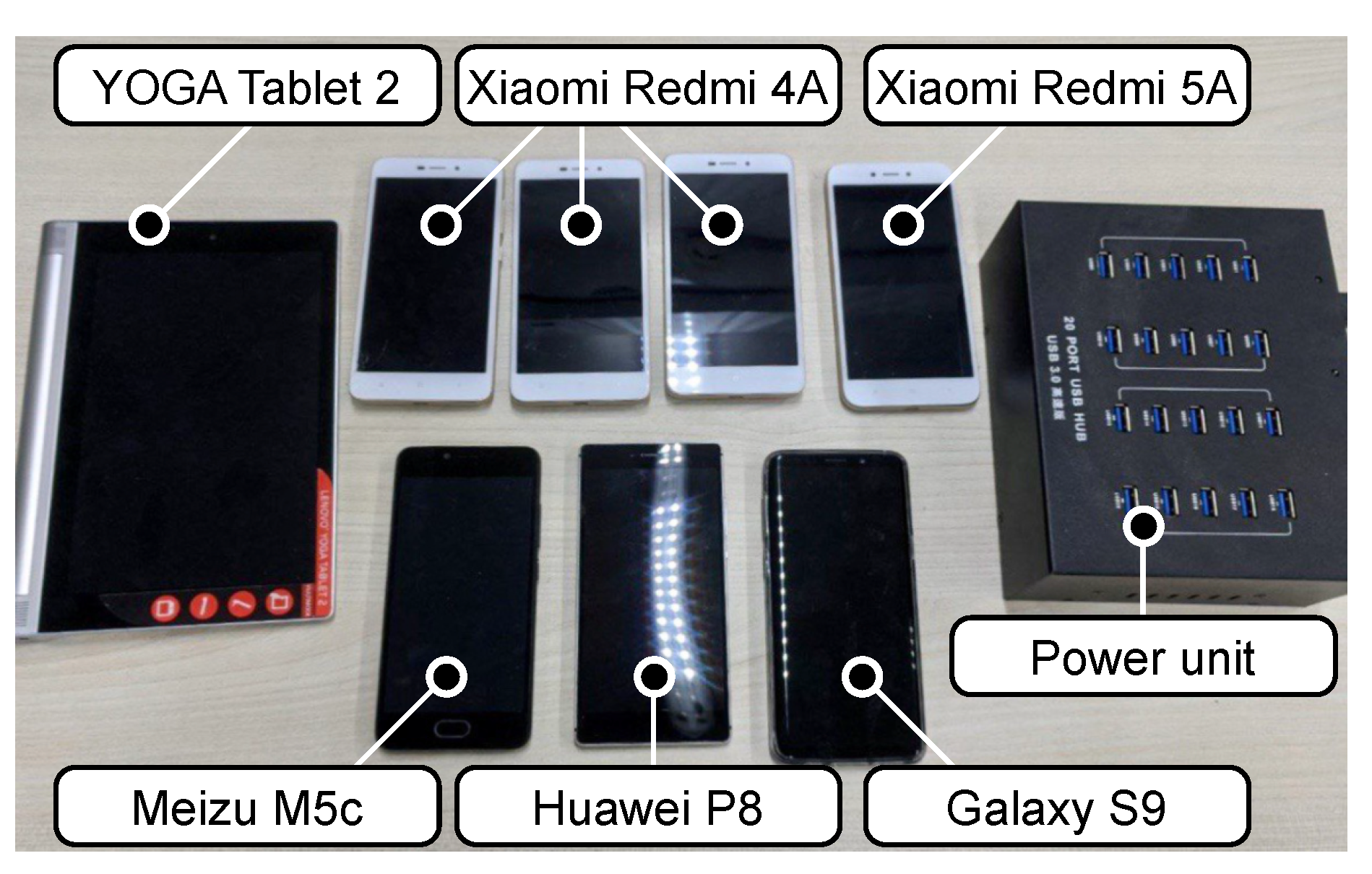
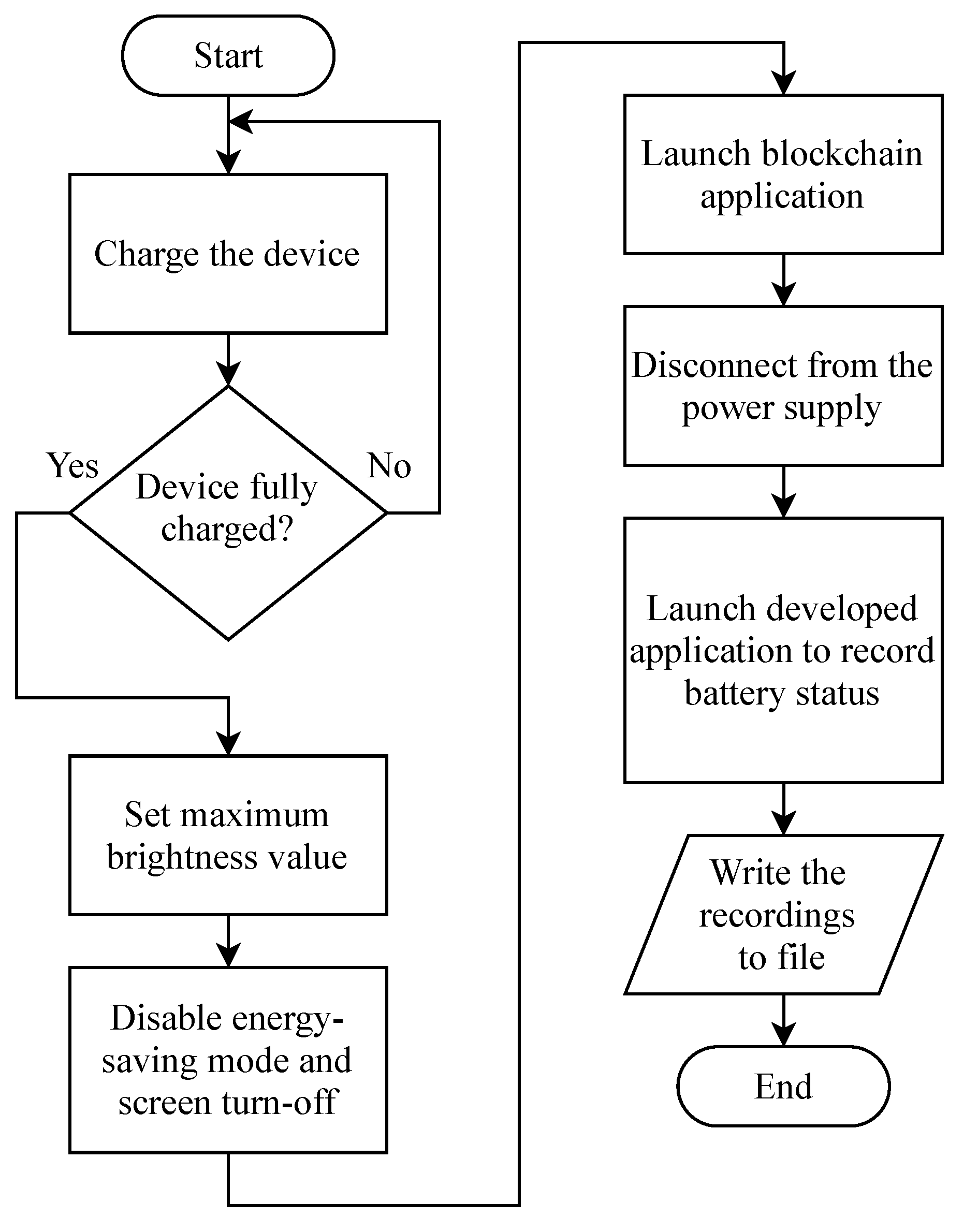
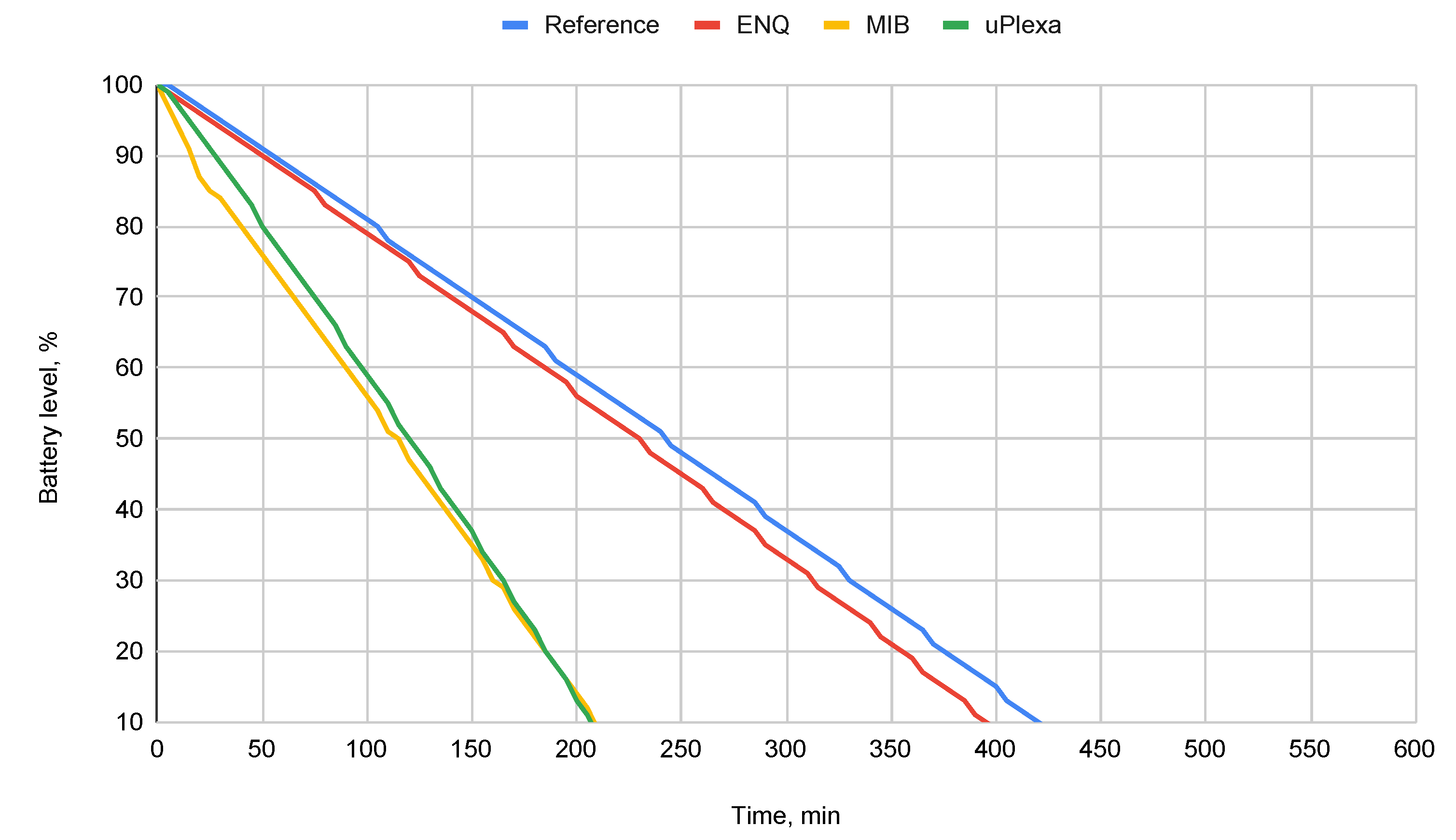
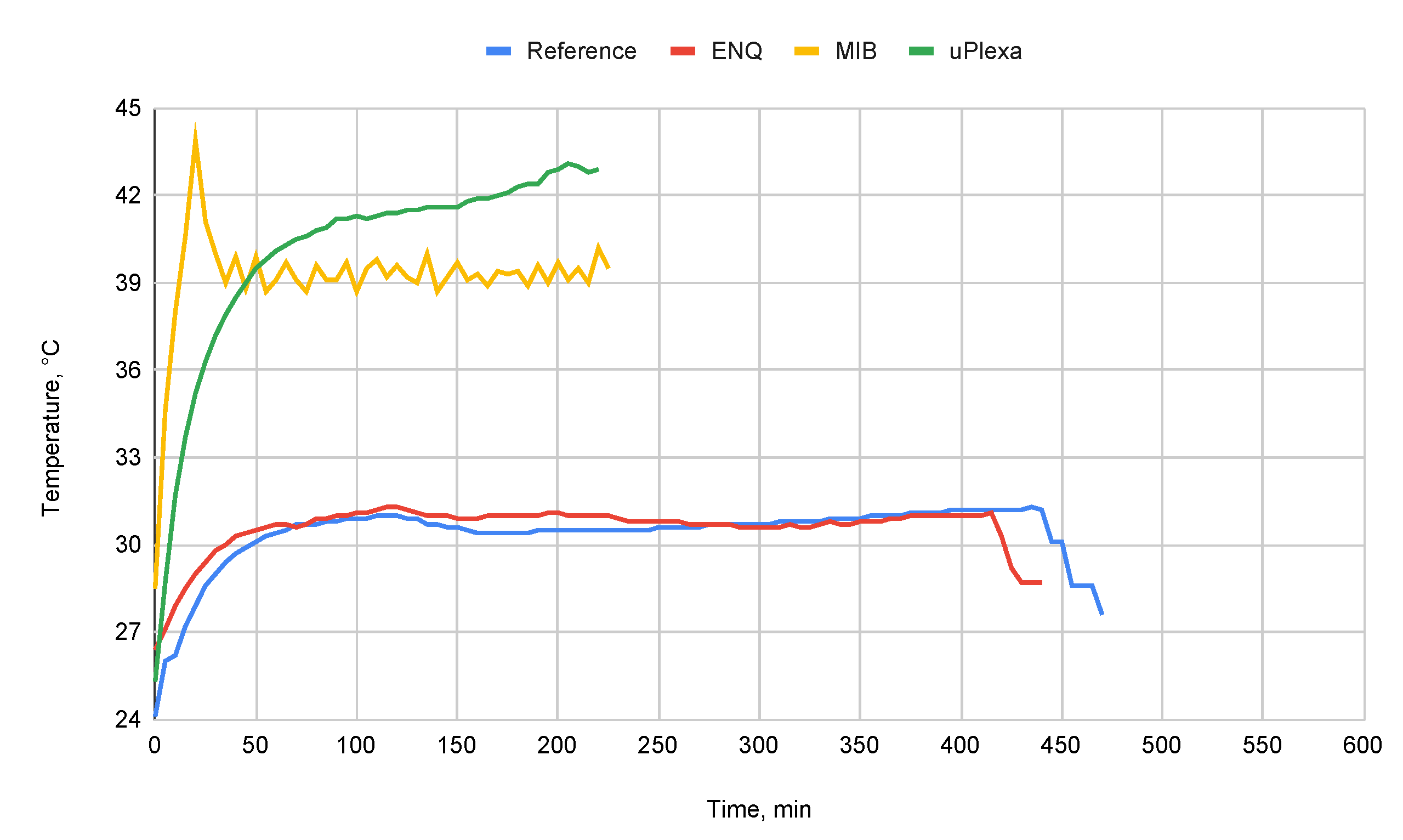
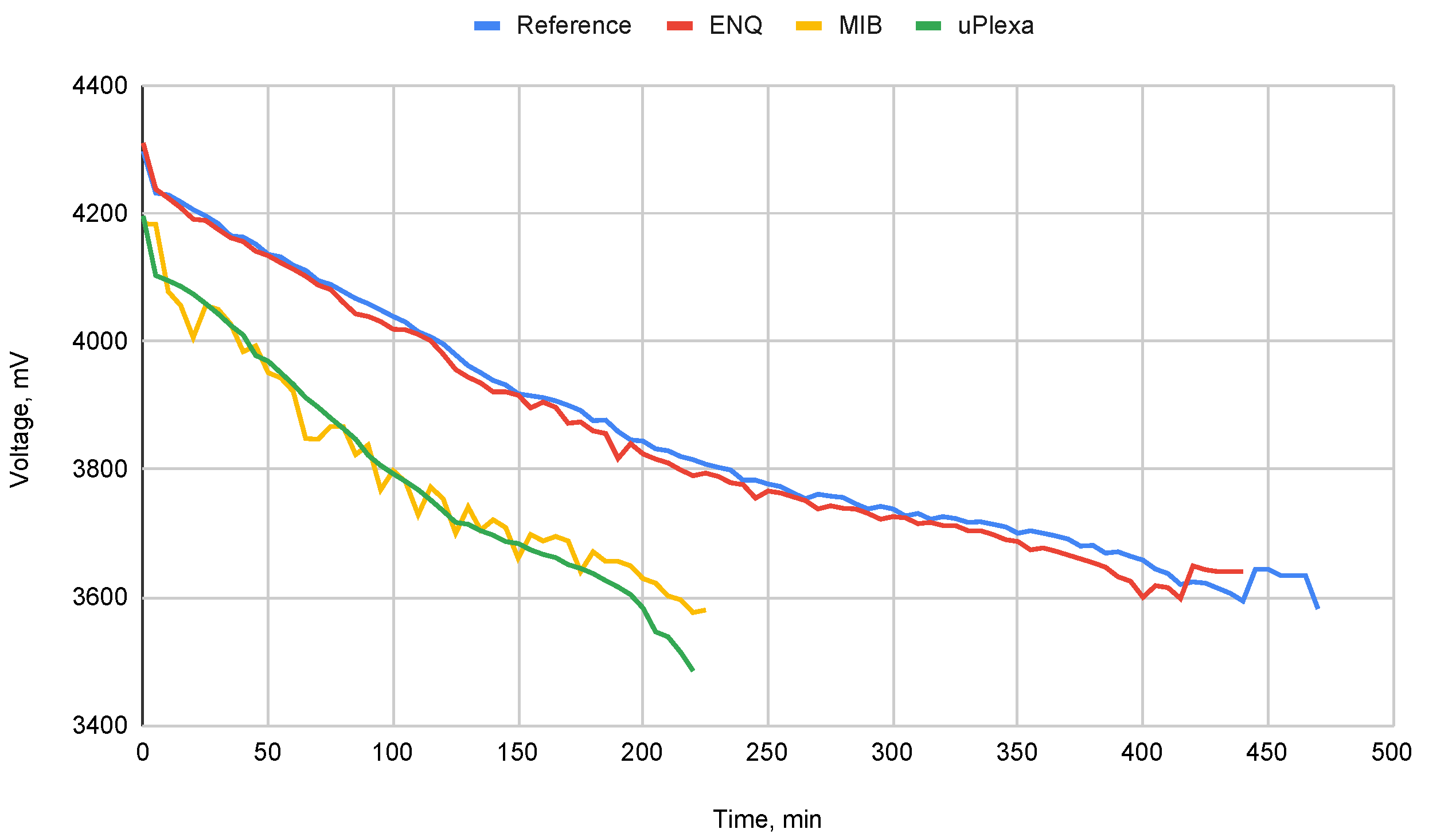
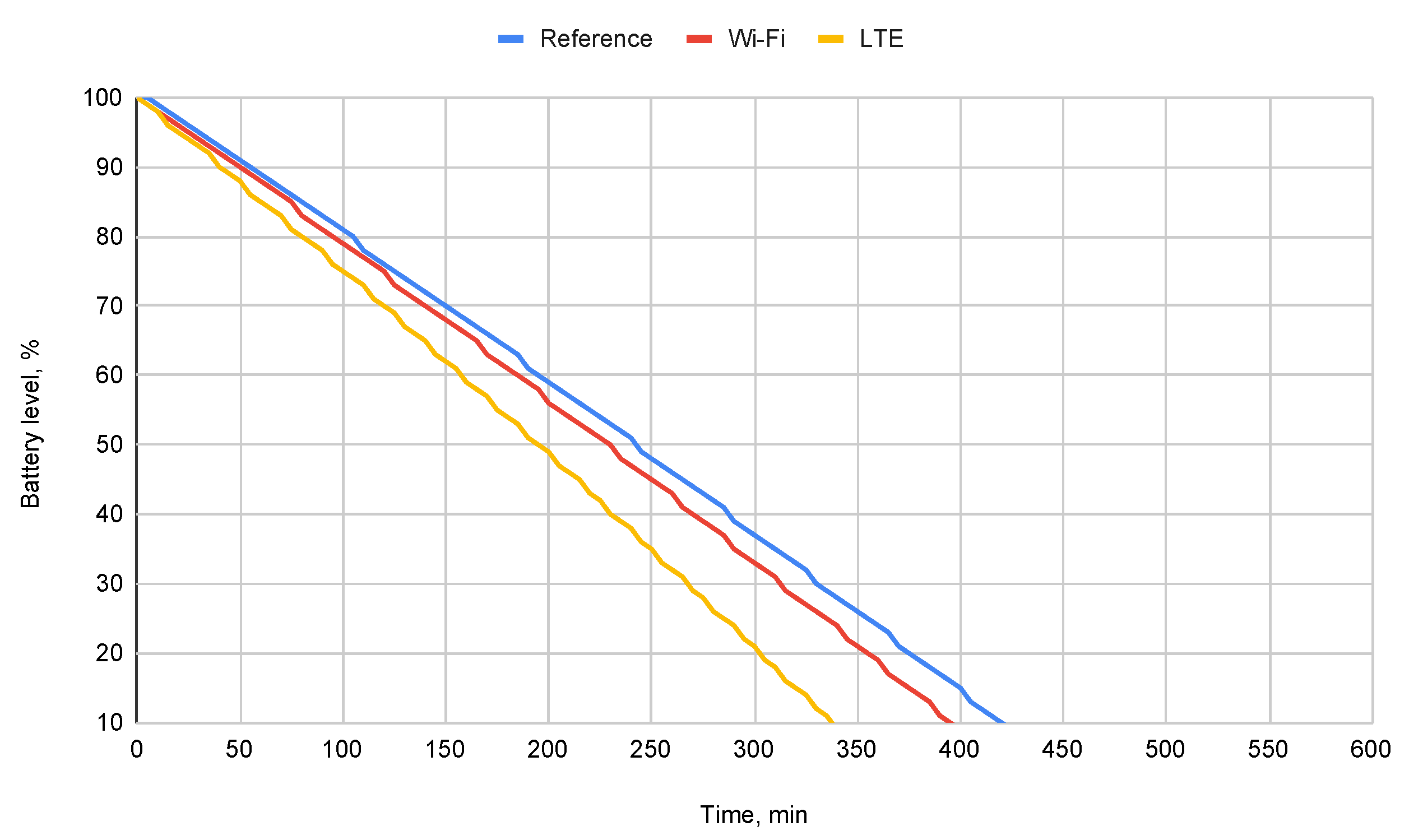
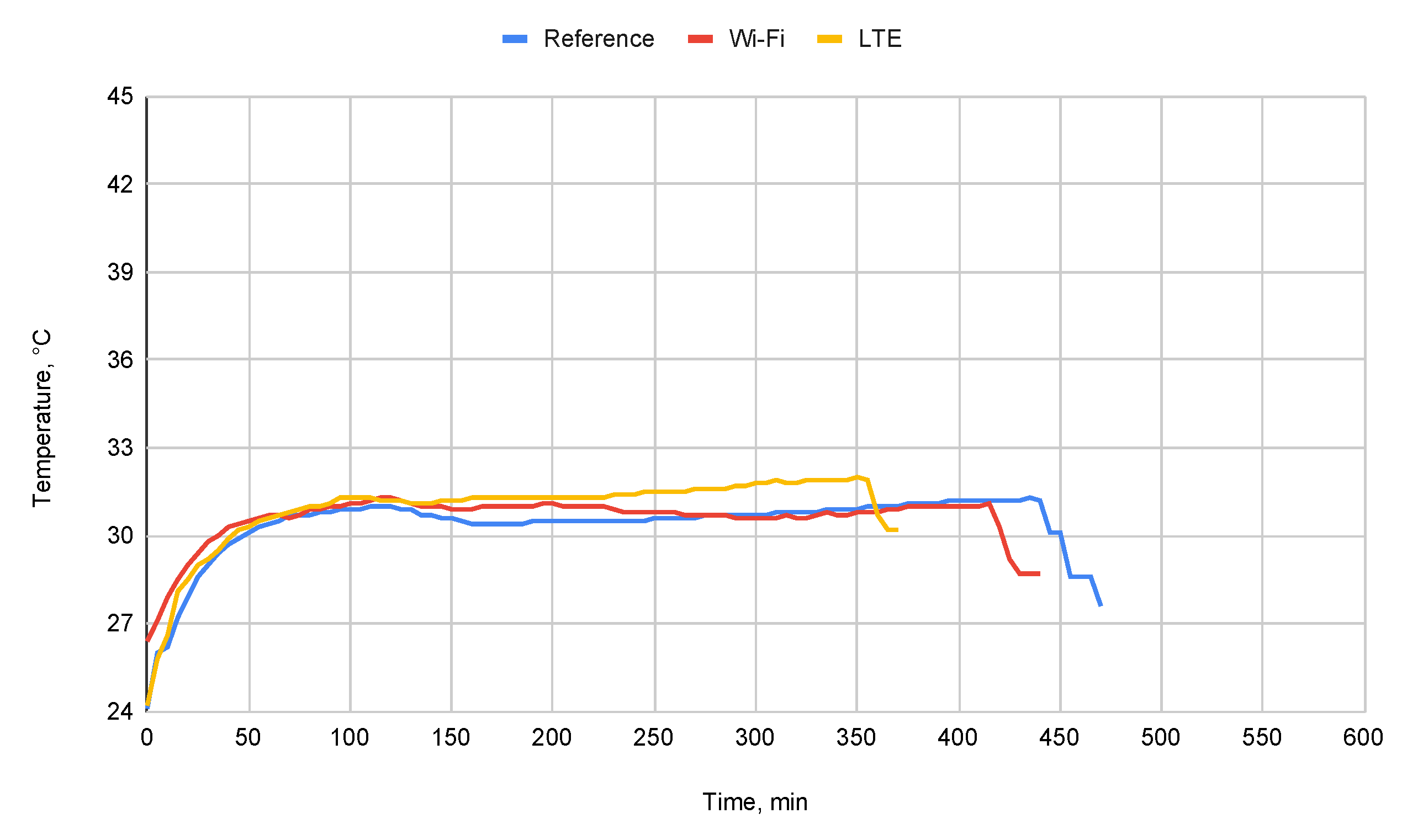
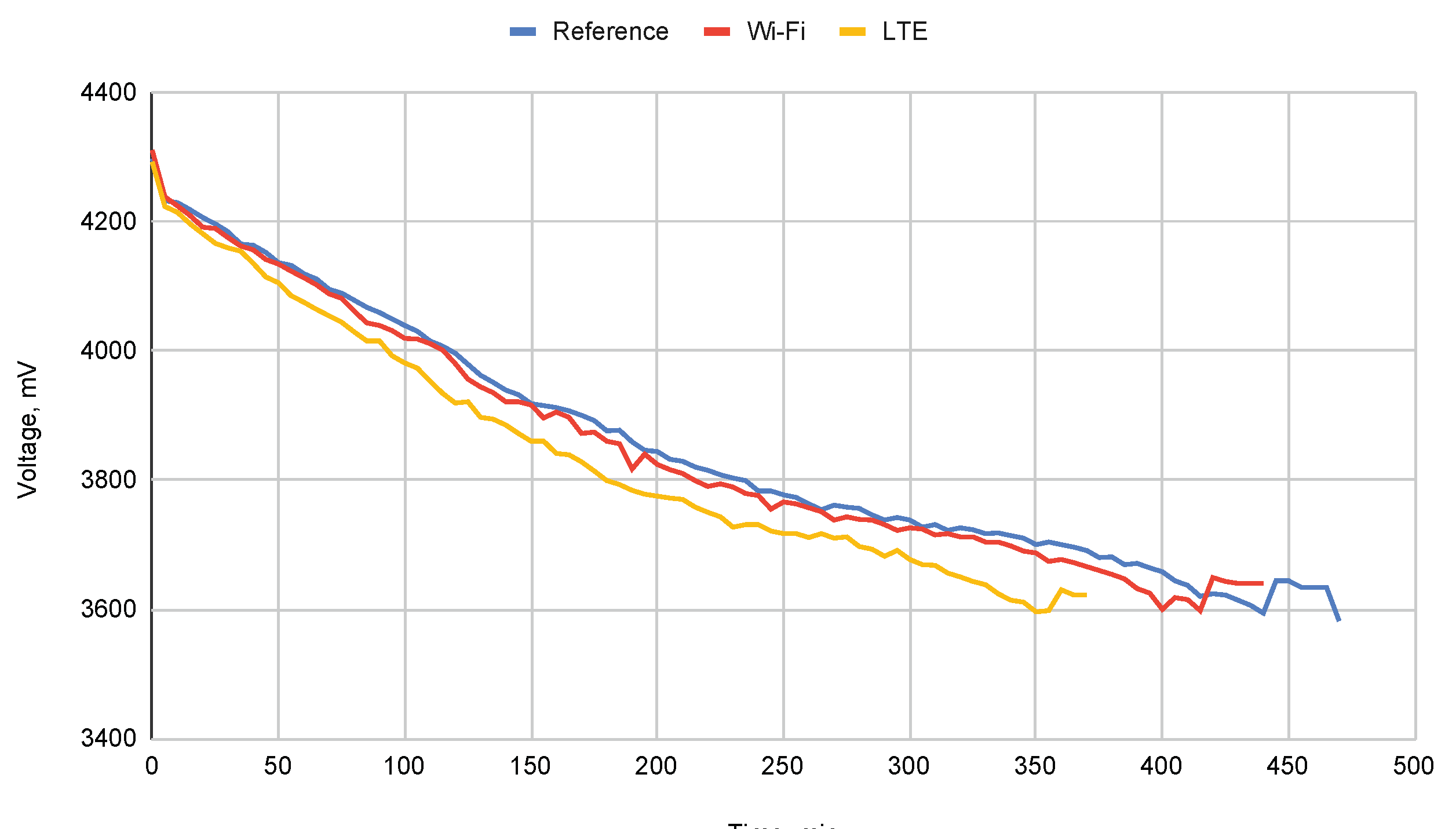
| Device Model | Android Version | Type | SoC | Processor | RAM | Battery |
|---|---|---|---|---|---|---|
| Samsung Galaxy S9 | 9.0 | Smartphone | Exynos 9810 | 2.7 GHz Quad-Core Mongoose M3, 1.7 GHz Quad-Core Cortex-A55 | 4 GB | Li-Ion 3000 mAh |
| Huawei P8 | 6.0 | Smartphone | HiSilicon Kirin 930 | 2.0 GHz Quad-Core Cortex-A53, 1.5 GHz Quad-Core Cortex-A53 | 3 GB | Li-Ion 3400 mAh |
| Meizu M5c | 6.0 | Smartphone | Mediatek MT6737 | 1.3 GHz Quad-Core Cortex-A53 | 2 GB | Li-Ion 3000 mAh |
| Xiaomi Redmi 4A | 7.1.2 | Smartphone | Qualcomm MSM8917 Snapdragon 425 | 1.4 GHz Quad-Core Cortex-A53 | 2 GB | Li-Ion 3120 mAh |
| Xiaomi Redmi 5A | 7.1.2 | Smartphone | Qualcomm MSM8917 Snapdragon 425 | 1.4 GHz Quad-Core Cortex-A53 | 2 GB | Li-Ion 3000 mAh |
| Lenovo YOGA Tablet 2 8.0 | 5.1.0 | Tablet | Intel Atom Z3745 | 1.33 GHz Quad-Core | 2 GB | Li-Ion 6400 mAh |
© 2020 by the authors. Licensee MDPI, Basel, Switzerland. This article is an open access article distributed under the terms and conditions of the Creative Commons Attribution (CC BY) license (http://creativecommons.org/licenses/by/4.0/).
Share and Cite
Bardinova, Y.; Zhidanov, K.; Bezzateev, S.; Komarov, M.; Ometov, A. Measurements of Mobile Blockchain Execution Impact on Smartphone Battery. Data 2020, 5, 66. https://doi.org/10.3390/data5030066
Bardinova Y, Zhidanov K, Bezzateev S, Komarov M, Ometov A. Measurements of Mobile Blockchain Execution Impact on Smartphone Battery. Data. 2020; 5(3):66. https://doi.org/10.3390/data5030066
Chicago/Turabian StyleBardinova, Yulia, Konstantin Zhidanov, Sergey Bezzateev, Mikhail Komarov, and Aleksandr Ometov. 2020. "Measurements of Mobile Blockchain Execution Impact on Smartphone Battery" Data 5, no. 3: 66. https://doi.org/10.3390/data5030066
APA StyleBardinova, Y., Zhidanov, K., Bezzateev, S., Komarov, M., & Ometov, A. (2020). Measurements of Mobile Blockchain Execution Impact on Smartphone Battery. Data, 5(3), 66. https://doi.org/10.3390/data5030066








